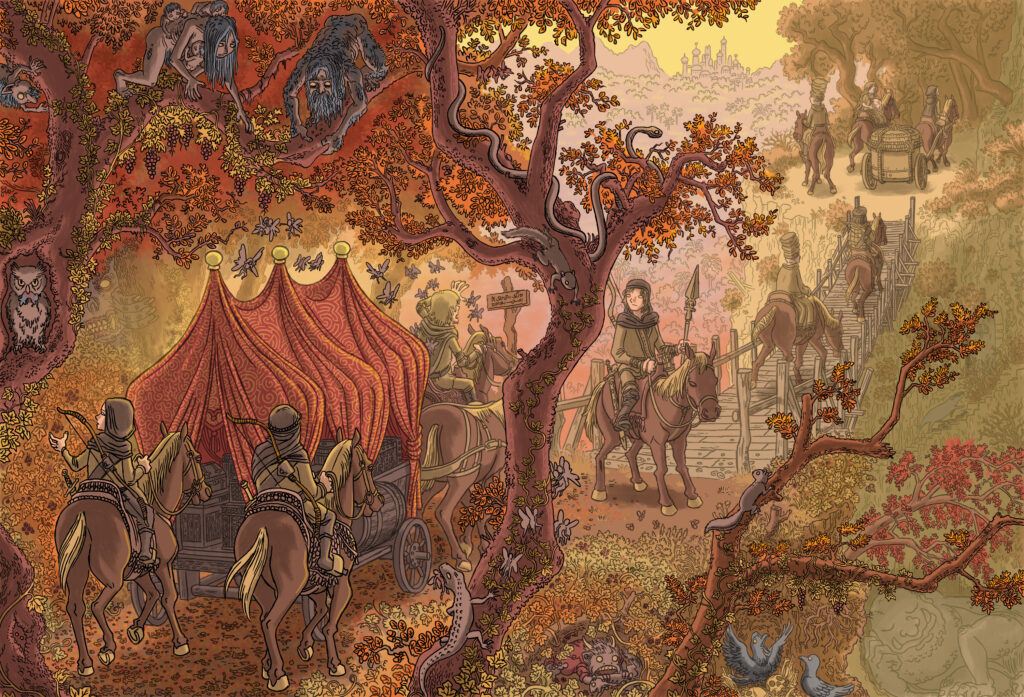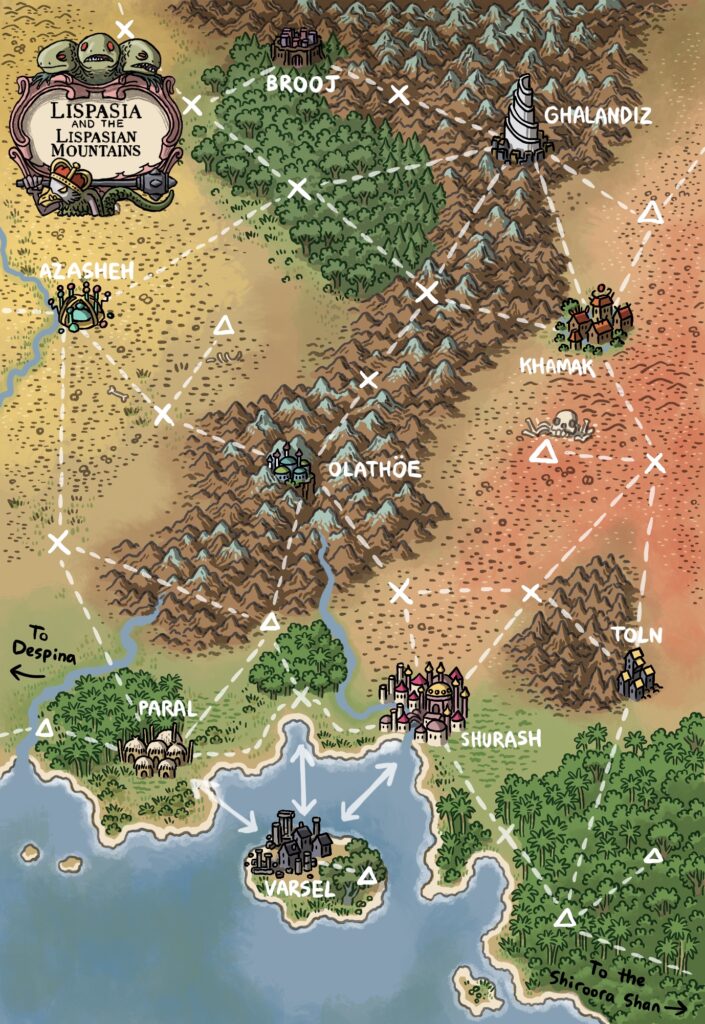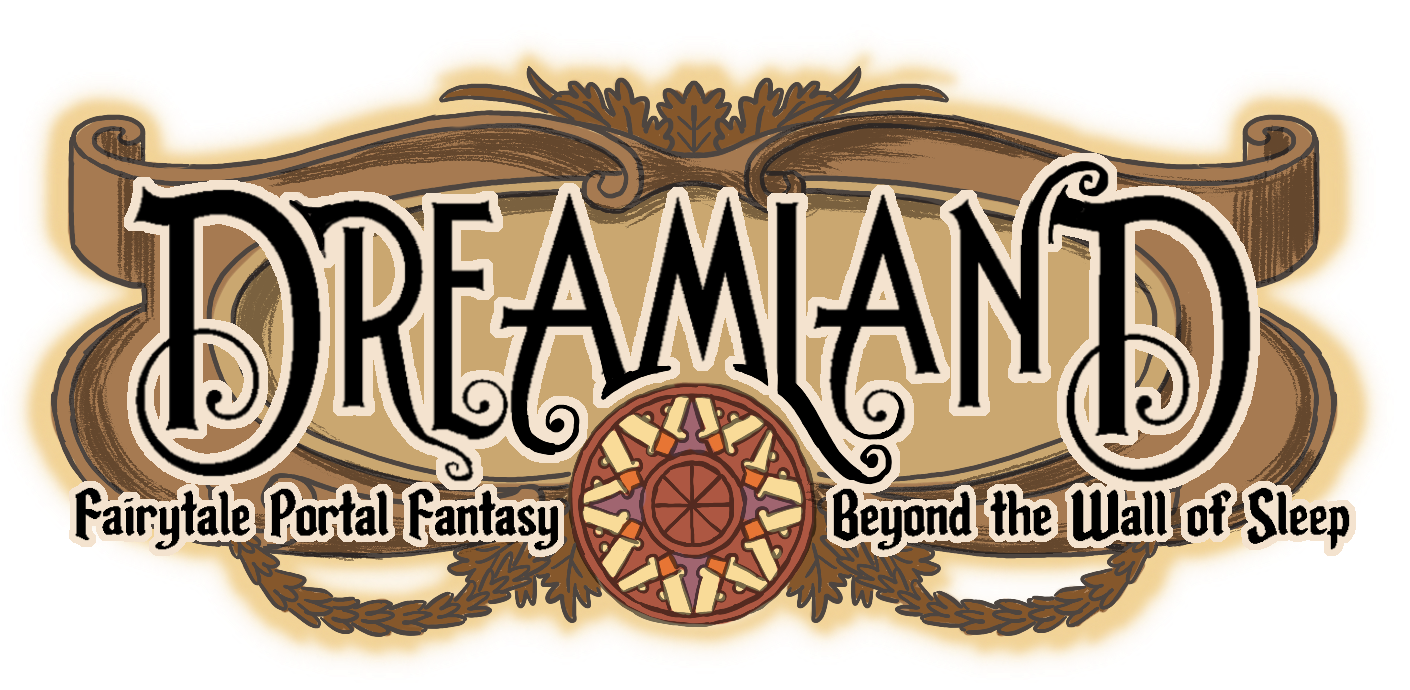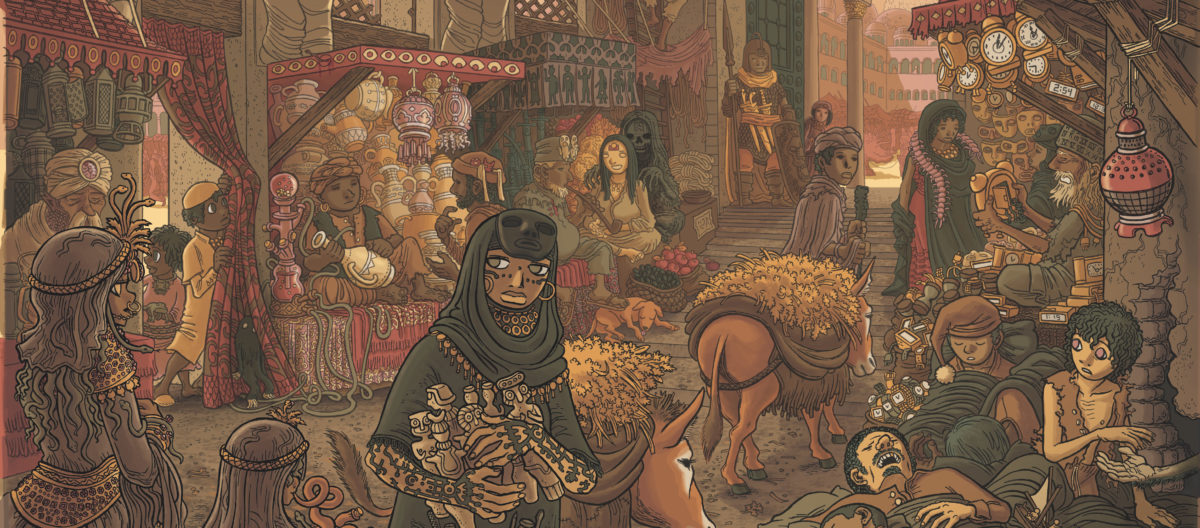
Whenever enough new folks join the Dreamland RPG Facebook group or Discord server, I’m going to be posting new Dreamland material (the FB and/or Discord folks get to vote on what it is). In celebration of the Facebook reaching 325 folks, here is this week’s new material, which I’m going to break into two parts.
Travel in Dreamland
Dreamland is infinite, and most of it is a vast wilderness unseen by human eyes. Endless jungles, forests and mountains stretch out in all directions. For fear of becoming lost, most travelers stick closely to the established roads, which stretch between the cities like the lines of astrological constellations connecting distant stars. Even traveling by road carries the risk of running out of food and water, being scorched in the desert sun or frozen in a snowy waste, or ambush by bandits or savage beasts. But the wilderness also hides strange beauty, rare plants and animals, and many other wonders.
Travel is an integral part of Dreamland and the stories that inspired it. In The Dream-Quest of Unknown Kadath, Randolph Carter travels throughout the dream world on many long journeys. Lord Dunsany’s story, “Idle Days on the Yann,” describes a leisurely river journey through fabulous cities. Travel narratives by authors like Faxian, Ibn Battuta and Marco Polo may also be inspirational for DMs. In a typical Dreamland game, the players travel, and some Roles will be comparatively powerful depending on where they go and what landscapes they roam.
Dreamland Terrains
Roads of Dreamland can pass through unearthly landscapes: oceans of bedsheets, pastoral gardens of giant geraniums, deserts of imaginary books dreamed by poets who never lived to write them down. In rules terms, however, landscapes are divided into five common types, and even the strangest landscape can usually be associated with one of them.
Pasture
Pasture, also known as pastoral land, is the easiest type of terrain for human travelers. It may be a flat green grassland broken by periodic streams, a shallow marsh, gentle rolling hills with light forest and copses of trees, or a dry veldt or savannah with occasional trees and bushes. Water and wildlife are comparatively abundant.
Civilization eats at the edges of pasture lands, with small farms and flocks of herd animals clustering within a few day’s travel of cities and towns.
Desert
Deserts are dry, inhospitable environments. Some are the archetypal rolling dunes of pure sand, such as those found in North Africa and the Arabian peninsula, but they can also be dry steppes of crumbling soil, wastelands of gravel and rocks, or a chaos of dry riverbeds and parched weeds that bloom once in a lifetime, when it rains.
Almost all deserts hold more life and water than first appears to be the case: small birds, lizards and foxes emerge from their burrows when night falls, and there is moisture under the sand, though you may have to dig for hours to gain a puddle of bitter water. A rare few places are truly lifeless, such as the vast deserts of rusty scrap metal, broken glass and discarded household items that surround the Dreamland city of X (accessible from the waking world via a train station near Belgrade).
Given centuries, human beings create new deserts: poor irrigation, erosion, logging and war transform jungles into grasslands and grasslands into dust. The desert represents the future. Scattered throughout Dreamland are the ruins of great technological civilizations now surrounded by thousands of miles of deserts, baking in heat or freezing in nuclear winter, like cauterized wounds in Dreamland’s skin.
Forest and Jungle
If a desert has too little life for humans to live there easily, a jungle or forest has too much. “Jungle” originates from the Sanskrit word jangala, meaning “uncultivated land;” in German it is Dschungel, “wasteland.” A jungle isn’t necessarily tropical and warm: it might be a tropical rainforest of palm trees, lianas and tall tree canopies, but it might also be a temperate rainforest of great moss-grown spruces and firs, or a vast dense mat of huge ferns.
The jungle represents the past, the primeval garden, the way the world was before humanity. A jungle landscape is moist and green, and water and food are easy to find; but it is also dangerous, a place where it is fatally easy to lose your way or be attacked by wild beasts. The common quality of all Dreamland jungles and forests is that they are inhabited by dangerous creatures that prey on the unwary.
Mountains
Towering and lofty, mountains present some of the greatest challenges to travelers. Dreamlanders believe that the Great Ones occasionally visit the highest mountaintops, and therefore they hold mountains in superstitious fear and awe. The mountains of Dreamland can rise far higher than the mountains of Earth, miles into the sky, where freezing temperatures, thin air and perilous trails make travel nearly impossible. Mountains represent the divine.
Seas and Lakes
Dreamland has fewer seas than the waking world because waking-worlders mostly dream of being on land. Like the waking world’s Caspian and Aral Seas, most Dreamland oceans are shallow and half-evaporated, and beneath their waters strange ruins of ancient civilizations can sometimes be seen. But a few great oceans remain, beyond whose storm-tossed waves are magical islands whose power and danger are quarantined by the waters. If you find the Queline Sea and sail for a thousand days, it is said you will come to the Basalt Pillars of the West, gateway to mystical Cathuria where all dreams are fulfilled.

Pointcrawling in Dreamland
Player characters in Dreamland typically “travel by map”, beginning with a map of potential destinations rather than wandering out blindly (unless they are in Fairyland, but that’s another question…). Roads are indicated by dotted lines on the map, stretching between towns (circles), cities (circles with dots), interesting sites (triangles), and cairns and crossroads (Xs). Routes over water such as seas or lakes are also treated as roads.
Roads are defined by the terrain they pass through (such as mountains, jungles, and so forth) and by their distance. Typically, unless the Pillar of Faraway has been broken, the distance between any two adjacent Xs or sites on a Dreamland map is one week long. In one of the few universal customs of Dreamland, people build cairns of stones at these week-markers to guide future travelers. Of course, traveling between week-markers does not necessarily take exactly a week; if the dreamers are riding fast-moving steeds like hippogriffs, their travel speed is improved; if characters are Exhausted, it will take longer.
Long Roads
A road that is more than one week long between sites is indicated by a number of weeks by the dotted line: 2, 3, 4, etc. Such roads are rare, but may be created by a “The World is Vast” Faraway Pillar Break.
Short Roads
Shorter roads (a journey of a day or a few days) also exist. They are indicated by arrows. Shorter roads take less time to travel and traversing them is an easier target number for the Wilderness challenge (see below).
Special Sites
Sites are indicated by triangles. A special site could be anything the DM imagines, such as an oasis, a castle, a famous inn, or an ancient ruin. It could also mark not a landmark, but a wilderness area of particular peculiarity or danger, such as a place frequented by monsters
Wilderness Challenges
First, the dreamers look at the map and choose their destination and how to get there. Then, the DM tells them the target number for the Wilderness challenge(s) for their route or choices of routes. Dreamers may collaborate on Wilderness challenges, up to the usual limit of the Collective Pool; and Wilderness challenges are simple challenges (i.e. the dreamers know the exact target number beforehand).
Dreamers can freely pass over Xs (cairns and crossroads) but must stop if they come to a circle (town), a concentric circle (city), or the edge of a lake or sea they wish to cross. Based on the DM’s decision, they may or may not be able to pass through a triangle (site) without stopping. For instance, if the site is a bandit’s camp, the dreamers might have to stop to fight the bandits as they pass through the first time, but after defeating them can pass easily. Or, if the site is along a river, the dreamers might have to stop if they wish to cross the river, or they can pass easily if they are staying on the same side of the riverbank.
Essentially, if dreamers travel short distances and stop frequently, they face easier Wilderness challenges but are more likely to have dangerous random encounters with bandits, beasts and monsters. If they ambitiously travel long distances without stopping, they face more difficult Wilderness challenges and are likely to arrive exhausted, hurt, hungry and thirsty.
Dreamers must always stop at towns, cities, important sites (as defined by the DM) and the water’s edge.
Terrain Type Wilderness Target Per Short Road Per Week
Pasture/marsh/river 1D6 +1 +2
Jungle/forest/mountains 1D6 +2 +4
Desert/sea/lake 1D6 +3 +6
If you pass through multiple types of terrain, add the total value of all the distances of each type of terrain. For instance, if you pass through two weeks of pasture and a short distance of desert, your Wilderness target number is 1D6+2 [one week of pasture] +2 [one week of pasture] +3 [short distance of desert], or 1D6+7. In addition, if dreamers pass through even a short distance of jungle/forest, mountains or desert, even as part of a longer journey through pasture lands, they suffer the special dangers of those terrains (see below).
If dreamers are in a boat, they can travel along most rivers as if they were pasture. If they are on foot or riding a non-amphibious steed, they must treat the river road as if it were the surrounding terrain.
If a road is more than a week’s journey long due to The World Is Vast Pillar Break effects, dreamers can’t stop midroute; there’s simply no good place to rest and camp. They must attempt to make the entire target number.
Traveling across a sea or lake typically requires a boat or raft (or friendly water beasts to ride on). If the dreamers don’t have something suitable, each dreamer must make a Swimming challenge against the same target number as the Wilderness challenge, or they drown midway on the journey.
If the dreamers break the Pillars while making their Wilderness challenge, the DM should describe the results as a consequence of travel: becoming Half-Awake because the landscape reminds them of the waking world; becoming Obsessed with things seen or experienced on the road; the landscape itself changing and becoming more perilous (especially for a Faraway break), etc. The DM might also choose to replace the normal Pillar Break effect with a random encounter (see below).
If a Wilderness target number is clearly out of the dreamers’ reach, the players may always opt to not spend any Words and let the failure dice fall where they may.
Wilderness Failures
When a Wilderness challenge fails, the party consumes all their food and/or water and every dreamer arrives at their destination with the Hungry/Thirsty Impairment (which, depending on the landscape, may represent hunger, thirst, or both). The exception is desert: if even part of the journey is through desert, every dreamer gains two Hungry/Thirsty Impairments, usually killing them.
Since a dreamer doesn’t die of hunger or thirst unless they have two copies of the Hungry/Thirsty Impairment, in game terms it’s impossible to starve on a journey unless the journey passes through desert or one is already Hungry/Thirsty when one sets out. In either case, if a dreamer is about to die of hunger or thirst, the DM should give them one last chance to save themselves in some creative manner using a marvel: a sudden rainstorm created by a Wonder marvel, the landscape shifting to green river land from a Faraway marvel, a friendly traveler with waterbags from a Passion marvel, waking up before they die with a Mystery marvel, etc.
In addition, roll 1D10. If even part of the journey is through mountains, subtract –2 from the roll. When a roll indicates dreamers are Injured or Exhausted, randomly determine who is affected, except that dreamers without the Wilderness skill receive Impairments before dreamers with the skill. Injuries sustained while traveling are usually leg or foot injuries caused by missteps but could also be scars from thornbushes or stinging nettles, back injuries from carrying heavy supplies, and so on.
Wilderness Failures
1D10 Effect
1 all become Hungry/Thirsty; 1D6 dreamers are Injured and Exhausted; vehicles (if any) are destroyed
2 all become Hungry/Thirsty;1D6 dreamers are Injured; vehicles (if any) are destroyed
3 all become Hungry/Thirsty;1D6 dreamers are Exhausted; vehicles (if any) are destroyed
4 all become Hungry/Thirsty;1D6 dreamers are Exhausted
5–6 all become Hungry/Thirsty; one dreamer is Injured
7–8 all become Hungry/Thirsty; one dreamer is Exhausted
9–10 all become Hungry/Thirsty (no extra results)
If an overland vehicle such as a wagon is destroyed, dreamers may lose their extra supplies since they have no way to carry them. A simple challenge of 8 in a Craft skill like Carpentry may be able to fix a damaged wagon.
If a vehicle is destroyed at sea, the ship sinks. If this happens when the travelers are at sea, they must make risky Swimming challenges of 1D6+2 or die; if they succeed, they are left clinging to driftwood, a lifeboat or an improvised raft. If this happens as the travelers approach dry land, the ship founders and sinks just as it gets to the travelers’ destination; the DM determines the Carpentry or Sailing skill challenge needed to repair it. The DM might also decide that a ship takes other types of damage, such as the sails being destroyed.
Random Encounters
Bandits, beasts and monsters haunt the roads of Dreamland. There are two ways for dreamers to trigger a potential random encounter:
(1) Whenever dreamers stop at a cairn or crossroads (an “X” on the map), they must roll to see if they have a random encounter. This happens whether or not the dreamers succeed in the Wilderness challenge. Players roll 1d6; an encounter occurs on a 1. This increases to 1–2 if the dreamers have a wagon (or a ship on the water) or are accompanied by a group of NPCs, or a 1–3 if the dreamers are accompanied by a caravan, horde, herd or army.
If the crossroads is in the jungle or forest, increase the number on which an encounter occurs by 1, so that, for instance, a caravan stopping at a forest crossroads has an encounter on 1–4.
(2) If the dreamers make a Pillar Break on a Wilderness challenge while traveling, the DM can choose to replace a normal Pillar Break effect with a random encounter. If the Night Clock is 3 or higher, the random encounter replaces just one of the multiple Pillar Breaks: i.e., if the Night Clock is 5 and the dreamers break the Pillars of Mystery and Wonder, the dreamers might lose a half-Memory (Wonder) and also encounter mysterious beasts (replacing the normal Mystery Pillar Break). Optionally, the DM might choose the type of random encounter based on the particular Pillar which broke (for example, fairies or centaurs for Passion, or loathsome monsters for Loathing).
To be continued in Travel: Part 2 with information on special steeds, supplies, etc.

